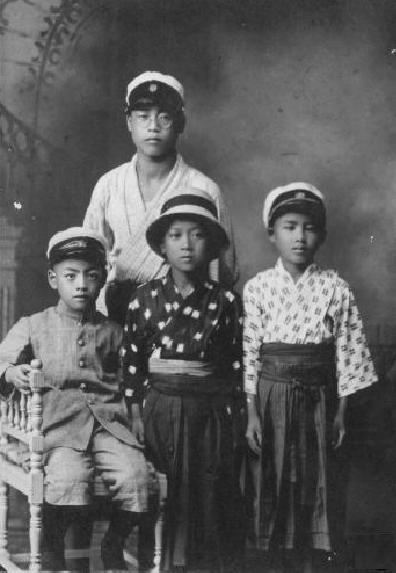
Japanese School Headwear: Chronology

Figure 1.--This family portrait shows four children in their school clothes. It is undated, but looks to have been taken in the 1920s. The portrait was taken by the Gifu studio. The younger children wear hakamas and the older children Western military styled school uniforms. They are wear Western styled headwear. Three of the childre war cadet cap. The other child wears a sailor hat, but I am not sure about that child's gender. We have not noted boys wearing hats like that. We think she is a girl, but I am not sure. A reader tells us, "The four are boys. The one with the brim hat is wearing a kimono with trousers. At the time, only males wore trousers with kimonos like that."
|
|
We have developed some chronologicalm information about Japanese school headwear. We know virtually nothing abiout the early- and mid-19th century, but Japan did not have a public school system at the time. Japan developed a modern European-style education system in the late-19th century as part of the Meiji Restoration. The Government chose military style uniforms including cadet caps. We note boys wearing cadet caps as their only item of school uniform in the late-19th century. They wear these cadet caps with traditional clothing. This was very common in primary schools, but we also see it as secondary schools as well. Sailor uniforms were chosen for the girls which including sailor hats, but few girls attended school in the 19th century. We continue to see primary boys wearing cadet caps with tradotional clothing in the early-20th century. Gradualy we see western-style uniforms in city primary schools. And secondary schools generally adopted the cadet uniforms. A good example is the Toba Shousen High School in the 1900s. we see some traditional clothing at secondary schools, but this was perhaps on special days. There was some variaruin from school to school. Many elementary schools did not have uniforms, but students might still wear the military-style caps with regular clothes. Secondary schools did require the uniforms. We note these miilitary styles in the early-20th century through the World War II period. After World War II we see a much wider range of headwear styles. Most secondary schools did continue to have uniforms with the military-style headwear. The primary schools, however, adopted many different hedwear styles, mostly non-military styles. Most were different kinds of caps, but there were also hats. We note some medium-brimmed hats worn by both boys and girls. Younger children commonly wore brightly colored caps, but I am not sure just when this convention was introduced. We have not yet noted important changes in the 21st century.
HBC-SU

Related Cap Pages in the Boys' Historical Web Site
[Return to the Main Japanese school headwear page]
[Return to the Main school uniform cap page]
[Main cap page]
[American caps]
[Australian caps]
[English caps]
[New Zealand caps]
[Scottish caps]
Navigate the Relate Boys Historical Clothing Uniform Garment Pages
[Main garment page]
[Blazers]
[Bookbag]
[Caps]
[Coats]
[Hose]
[Kilts]
[Pants]
[Shirts]
[Shoes]
[Smocks
[Suits]
[Seaters]
[Ties]
Navigate the Boys' Historical Clothing School Uniform Country Pages
[Main School Uniform Page]
[Main National School Uniform Page]
[Australia]
[England]
[France]
[Germany]
[Ireland]
[Italy]
[Japan]
[New Zealand]
[Poland]
[Singapore]
[Scotland]
[Singapore]
[United States]
Navigate the Boys' Historical Clothing Web Page
[Introduction]
[Activities]
[Biographies]
[Chronology]
[Clothing styles]
[Countries]
[Bibliographies]
[Contributions]
[Essays]
[FAQs]
[Glossaries]
[Images]
[Links]
[Registration]
[Tools]
[Boys' Clothing Home]
Created: 7:20 PM 3/21/2008
Last updated: 3:25 AM 8/12/2012




